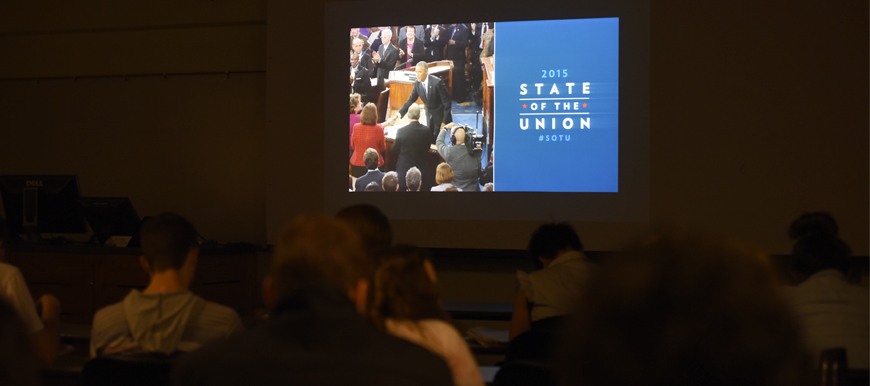From D.C. to Logan: Students and faculty gather to watch the State of the Union address
Members of the Utah State University student and faculty population gathered in the Merrill-Cazier Library to watch the State of the Union address with free pizza, provided by the USU chapter of Pi Sigma Alpha.
Pi Sigma Alpha, the national honors society of political science, invited two professors from the political science department to address the crowd about what to expect during the president’s speech.
Jeannie Johnson, assistant professor in the Political Science Department spoke to students about the political strategy the president would use to make his agenda seem more popular, specifically how the president would portray foreign enemies such as North Korea and ISIS to appear as a tough commander-in-chief.
Johnson said the president’s decision to invite Alan Gross, the American recently released by Cuban authorities after years in captivity, to the speech was an example he would use to show the success of his decision to normalize relations with the communist country.
Michael Lyons, former head of the Political Science Department, saw the address as a way for the president and his Democratic Party to set a precedent for the 2016 presidential election.
“The road to 2016 has begun,” Lyons said. “Act one was Jeb Bush stating his intentions to run for president. Act two was Mitt Romney stating his intentions, and act three is tonight.”
Lyons said the agenda would be to show the successes seen under the Obama administration to portray the need of electing another democrat to the Oval Office in 2016.
President Barack Obama addressed both houses of Congress in the chambers of the House of Representatives on Capitol Hill in Washington D.C.
In a speech that lasted roughly an hour and 15 minutes, the president laid out his agenda for the coming year, including hot-button domestic and foreign-policy topics, such as the threat of terrorism around the world, equal pay for equal work, comprehensive child care and climate change.
Obama also expanded on his proposal to offer two years of community college to all eligible American students tuition free. With this proposal he also echoed his previous statement of focusing on lower student loan rates and helping college students pay back previously acquired debt.
Anna Marchant, president of the USU College Republicans, had both agreements and disagreements with Obama’s course of action in the case of college tuition.
“I agree with his sentiments that we do need more affordable education for a wider variety of people,” she said. “However I would always push for those policy changes on the state level, avoiding the need for citizens to rely on the national government.”
Anna Harris, a senior majoring in political science and French and a member of the USU College Democrats, was surprised by the direction of the address.
“I was impressed on the number of things he decided to talk about that I felt he wouldn’t address, such as drones and torture policy which have been sticky points within the democratic base,” Harris said.
Marchant had similar sentiments.
“I felt that he was really bold, which frankly I was really impressed with,” she said. “He surprised me on a few of the issues I thought he would shy away from, such as gay and lesbian rights. He did call for bipartisanship, but from the looks in the crowd the partisanship was as thin as ever.”
—
Twitter: @claybmarsh

